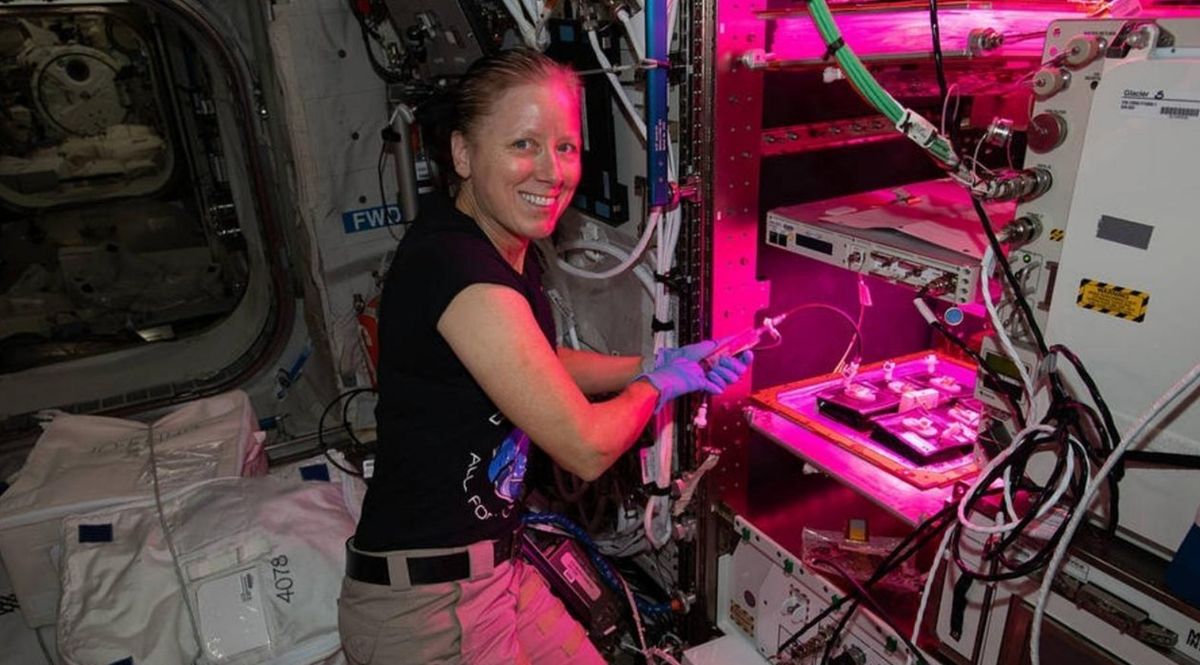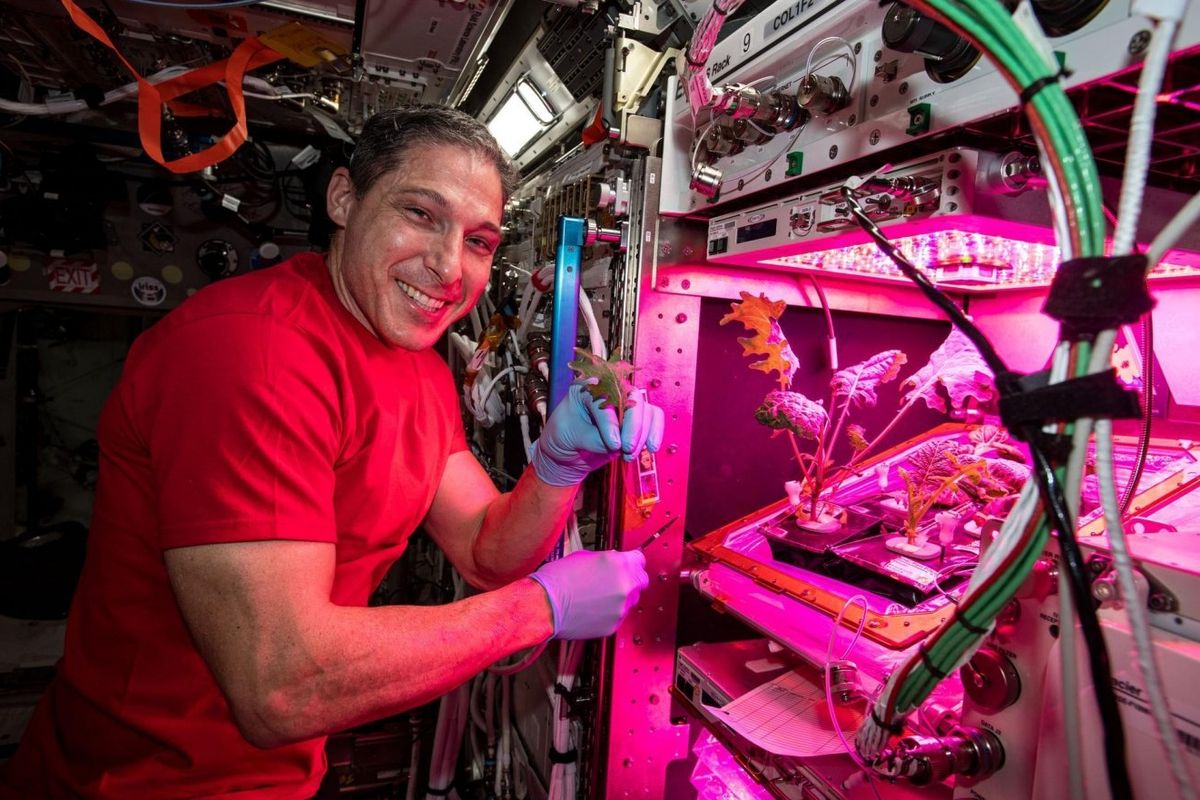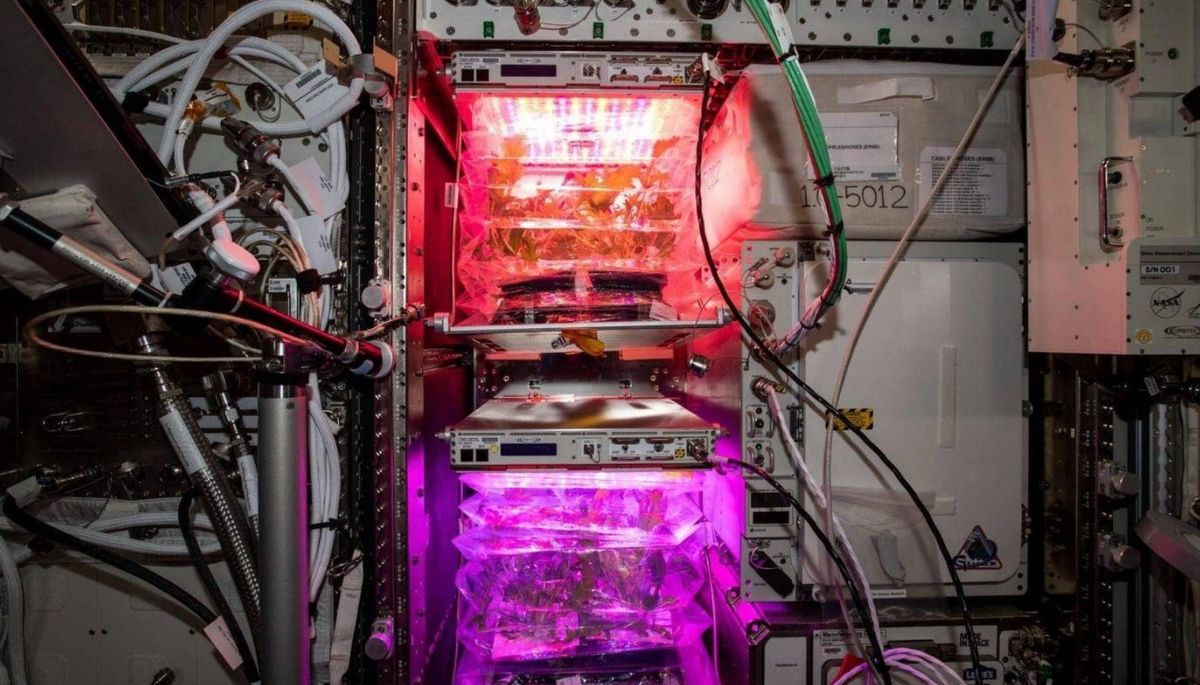Alfalfa in space: Inside a WSU professor’s experiment on the International Space Station
NASA astronaut, Michael Hopkins, interacted with and nurtured the Arabidopsis plant during the Final Frontier Plant Habitat in spring 2018. (Courtesy of Norman Lewis)
A Washington State University experiment that could impact the ability of humans to live beyond earth is expected to arrive in space next year as astronauts plant a cosmic garden in orbit.
Sometime between February and April, Norman G. Lewis, regents professor at WSU and fellow of the Institute of Biological Chemistry, will use the microgravity laboratory on the International Space Station for a project called, “Dissecting beneficial plant microbe interactions focused on the ISS space flight environment.” While he won’t be on the ISS himself, he and his team of about 20 people – six from WSU – will do most of the prep work and tell the astronauts aboard the ISS the best ways to take care of the plants.
Since humans first began to live and work on the ISS around 21 years ago, over 3,000 science experiments have occurred on the globally shared, out-of-this-world stepping stone. Lewis has worked on ISS experiments before. This time, he’s focused on nitrogen fixation.
Although nitrogen makes up nearly 80% of our atmosphere, plants are unable to use nitrogen gas directly. Nitrogen fixation is a process in which bacteria in the soil, called rhizobia, absorbs nitrogen in the air and combines it with oxygen or hydrogen to form compounds, such as ammonia, that plants can use for fuel. It’s essentially a way for plants to fertilize themselves.
“One of the main reasons for doing this is that as one considers going to the moon or to Mars, the ability to just grow plants so far away is gonna have a great demand on things like fertilizer,” Lewis said. “We’re looking at plant materials and things like alfalfa, peas, legumes. These things are plants, so they can all be grown with the bacteria to fix nitrogen and thereby be able to reduce the amount of fertilizer that would have to be brought up into space.”
Legumes are plants that produce seeds in pods. With almost 19,000 different species, legumes are different than most plants because many have root nodules that form a symbiotic relationship between themselves and the rhizobia bacteria in the soil. The bacteria enter the legume’s root, multiply and form nodules that turn atmospheric nitrogen into ammonia. In return, the legumes offer all the nutrients and energy that the bacteria need to survive. Another benefit of nitrogen fixation in legumes is that sometimes legumes release the “fixed” nitrogen back into the soil for other plants to use.
About 288 alfalfa seeds will be sent into space for six weeks until they’re harvested, frozen and eventually returned to Earth to be studied. All preparatory work will occur at the Kennedy Space Center, and then the plants and other needed materials will be transported to the ISS via a spaceship at the Wallops Flight Facility in Virginia.
Studying nitrogen fixation is only half of the experiment. Lewis also is examining lignin levels in alfalfa plants. Lignin is found in the cell walls of plants and functions in a similar way to the bones in the human body, he said. Without lignin, plants lack adequate structural support. The goal of the experiment is to determine whether plants need the same structural reinforcement, in terms of lignin, to exist in an environment that isn’t Earth. The more lignin a plant has, the harder it is for that plant to biodegrade.
If plants can grow well in microgravity with less lignin, the inedible parts would biodegrade easier “and regenerate the building blocks for the next generation of plants,” Lewis said.
“Go back to the moon or Mars colonization and settlements and looking at growing plant materials, you would like to have a material that had less of this lignin but still was able to perform its growth and development functions,” Lewis said.
Lignin can take hundreds, even thousands, of years to biodegrade. Lewis said future space colonizers wouldn’t want to plant crops that had high lignin levels because that means 85% to 90% of the vegetative matter wouldn’t be able to be reused. Plants with lower lignin levels that are still able to fully function would reduce the demand for resources sent from our planet to supply a foreign world.
Lewis worked on another project aboard the ISS in 2018 called the Final Frontier Plant Habitat that examined lignin levels in a plant called Arabidopsis – small, flowering plants related to cabbage and mustard. Some of the Arabidopsis plants aboard had normal levels of lignin, while others had levels lower than usual. Additionally, the Kennedy Space Center mirrored this experiment with one on the ground, so that scientists could compare and contrast the differences in all the Arabidopsis plants.
He is just beginning to compile and write the research papers from this experiment and expects all of the papers to be released to the public within 16 months. The same analysis will be done for the upcoming experiment once the plants make it to his lab, which Lewis suspects will be around February 2026. While the alfalfa will only be on the ISS for six weeks, Lewis said it may take up to 10 months for NASA to give him the plants back.
The Final Frontier Plant Habitat cost around $2.3 million. Lewis said his upcoming project cost the team around $650,000 to $800,000, but NASA’s cost will be more.
Video chat will allow Lewis to directly communicate with astronauts on board the ISS. On a day-to-day basis, Lewis said astronauts aboard the ISS will look at the plants, notice if germination is occurring and relay that information to Lewis and his team. Then Lewis may give the astronauts suggestions, such as tweaking the light or water levels.
One of the astronauts who may be up there at the same time is Spokane native Anne McClain. McClain was chosen on Aug. 10 to command the SpaceX Crew-10 mission to the ISS scheduled for February 2025. As of now, it seems her time on the ISS will coincide with Lewis’s experiment.
“Having plants growing up on the space station is very pleasant for (the astronauts) because it’s a reminder of home,” Lewis said. “It’s a reminder of Earth.”
Michael Kahn is a retired WSU professor, consultant and co-principal investigator on this project. He’s spent the last 45 years studying nitrogen fixation in alfalfa, just never in space. Lewis refers to Kahn as a guru when it comes to nitrogen fixation in legumes. Kahn’s responsibility for the project has been figuring out how to adapt the on-the-ground laboratory procedures to fit the constraints of the ISS.
Kahn said he’s had to determine how to orchestrate the project under limited space, how to use LEDs to grow the plants and how the germination and watering procedures will work so the rhizobia bacteria will be with the plants at the right time and place. Kahn said two plots, spanning roughly 9 by 12 inches, is the allotted space available for both of the experiments.
While Kahn, Lewis and the rest of the team have worked to mitigate chances of failure, challenges remain that could jeopardize their results. One of those challenges is ethylene, a colorless, flammable gas that exudes from many materials used to build space stations. It’s also a natural plant hormone that accelerates growth while simultaneously altering the symbiosis between rhizobia bacteria and the alfalfa.
Russia’s space station, MIR – which operated in low Earth orbit from 1986 to 2001 – had exorbitant levels of ethylene that ruined many of Russia’s astrobiology experiments. Ethylene scrubbers have been implemented in the ISS to keep the concentration levels down, but Kahn said NASA has not told him how much those levels have gone down. Other gasses, Kahn said, might be accumulating in parts per million or parts per billion that could cause problems with the symbiosis between the bacteria and the alfalfa.
Another challenge: watering the plants.
“One of the issues with growing plant materials in space and doing a lot of experiments in space is the behavior of water is very much different,” Lewis said. “So, for example, if you were to take a drop of water and put it on a soft tissue, Kleenex or something, it will just spread out on that surface. Whereas in space, the surface tension of water is much different, and it balls up rather than spreads out.”
Lewis and members of NASA have worked to improve how water is absorbed into the soil. They plan to use a material called Turface, which is used on baseball and other athletic turfs. Lewis said the surface is more porous than what previously was used. It works as a defense against water’s attempt to concentrate in one area. However, other issues, like cosmic radiation, lack of proper lighting and more issues that have yet to be found may also prove to negatively affect the plants’ growth.
Alfalfa generally is grown to feed livestock, not humans. Kahn said they chose to grow alfalfa because the seeds are small, the plants are resilient to stresses like heat and drought on Earth, and the size of alfalfa plants fits well within the parameters laid out by NASA. But what comes after alfalfa?
“We’re trying to see whether the symbiosis can be established, whether these plants and the bacteria are able to do the interaction that we can see very easily on the ground,” Kahn said. “If that works, then I think the question becomes, will it work for other similar plant microbe interactions, things like beans and peas and stuff like that?”





